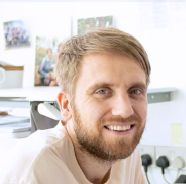

For full details, please see our lab website
 Research summary
Research summary
Research summary
My research tackles two major problems in developmental biology: (1) how do embryos ensure coordinated development to ensure robust
morphogenesis?; (2) how does complex organ shape emerge during developing? We focus on using quantitative biology techniques and
modelling to deepen our understanding of these important questions. We are particularly interested in the role of mechanical
interactions in guiding morphogenesis, and how such mechanics interacts with signalling networks during development.
Organ morphogenesis
My lab also studies how complex three-dimensional tissue shape emerges. Using the developing Zebrafish myotome as a model system, we have utilized light-sheet microscopy to create a four-dimensional map of the developing myotome. The myotome has signalling inputs from three orthogonal morphogens (BMP, Shh, FGF), as well as considerable cellular rearrangement and shape change. Using our maps, we have found, for example, that FGF determines slow muscle fibre cell fate, not by direct signalling, but instead non-autonomously by regulating the elongation and migration of fast muscle cells which subsequently displace the slow muscle fibres from the source of Shh. Relatedly, we are exploring the biophysics of the emergence of the distinctive chevron shape of the myotome. We have explored the role of differential mechanical interactions in the formation of the Drosophila heart. In particular, we have focused on the question of how cells of the same type reliably match during cardiogenesis. We have found that cell adhesion molecules Fasciclin-III and Teneurin-m act complementarily to provide an adhesion gradient across each heart segment, which results in reliable cell matching. Developing organisms are three-dimensional, yet much research into tissue mechanics and interactions has focused on relatively flat tissues, such as the Drosophila wing disc. We are exploring how cells arrange and compete for space in curved three-dimensional environments. Using theory and experiment, we have shown that during cellularisation in the Drosophila embryo, cells undergo skew and apical-to-basal neighbour rearrangements to adapt for geometric constraints. Finally, we are interested in organ scaling. Even between closely related animals there can be considerable variation in body size. Yet, for example, organs are typically positioned in the correct relative position for each specimen. Using light-sheet microscopy, we are using Drosophila embryogenesis to explore when and how such scaling decisions are made.
1. Narayanan R, Mendieta-Serrano MA, and Saunders TE. The role of cellular active stresses in shaping the zebrafish body axis. Curr Opin Cell Biol 2021; 73:69-77. [PMID: 34303916]
2. Saunders TE. The early Drosophila embryo as a model system for quantitative biology. Cells Dev 2021;:203722. [PMID: 34298230]
3. Yadav V, Tolwinski N, and Saunders TE. Spatiotemporal sensitivity of mesoderm specification to FGFR signalling in the Drosophila embryo. Sci Rep 2021; 11(1):14091. [PMID: 34238963]
4. Athilingam T, Tiwari P, Toyama Y, and Saunders TE. Mechanics of epidermal morphogenesis in the Drosophila pupa. Semin Cell Dev Biol 2021;. [PMID: 34167884]
5. Tiwari P, Rengarajan H, and Saunders TE. Scaling of Internal Organs during Drosophila Embryonic Development. Biophys J 2021;. [PMID: 34087212]
6. Colin L, Chevallier A, Tsugawa S, Gacon F, Godin C, Viasnoff V, Saunders TE, and Hamant O. Cortical tension overrides geometrical cues to orient microtubules in confined protoplasts. Proc Natl Acad Sci U S A 2020;. [PMID: 33288703]
7. Lenne PF, Munro E, Heemskerk I, Warmflash A, Bocanegra-Moreno L, Kishi K, Kicheva A, Long Y, Fruleux A, Boudaoud A, Saunders TE, Caldarelli P, Michaut A, Gros J, Maroudas-Sacks Y, Keren K, Hannezo E, Gartner ZJ, Stormo BS, Gladfelter AG, Rodrigues A, Shyer A, Minc N, Maître J, Di Talia S, Khamaisi B, Sprinzak D, and Tlili S. Roadmap on multiscale coupling of biochemical and mechanical signals during development. Phys Biol 2020;. [PMID: 33276350]
8. Mirth CK, Saunders TE, and Amourda C. Growing Up in a Changing World: Environmental Regulation of Development in Insects. Annu. Rev. Entomol. 2020;. [PMID: 32822557]
9. Zhang S, Teng X, Toyama Y, and Saunders TE. Periodic Oscillations of Myosin-II Mechanically Proofread Cell-Cell Connections to Ensure Robust Formation of the Cardiac Vessel. Curr. Biol. 2020;. [PMID: 32679105]
10. Hamant O, and Saunders TE. Shaping Organs: Shared Structural Principles Across Kingdoms. Annu. Rev. Cell Dev. Biol. 2020;. [PMID: 32628862]